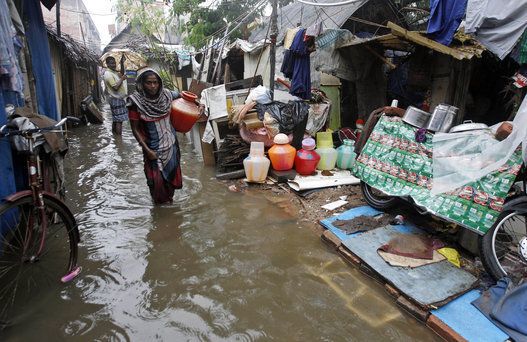
Chennai has recorded unprecedented rainfall that has surpassed century-old records. The rare event, according to experts, maybe linked to the global meteorological event called El-Nino, which is usually associated with a dry monsoon spell in India.
The official meteorological reason for the current spell of rains is the following. "...a slow-moving depression over southwest Bay of Bengal has triggered the fresh bout of heavy rain in Tamil Nadu... from a cyclonic storm that hit the state in November." However there are larger climate forces at play.
In El-Nino years, surface water temperatures in the Pacific Ocean rise between 0.5 to 1 C, causing warm air to rise and the colder, moisture-laden air that brings monsoon rain to India is pulled away from the mainland. During India's winter, when rainfall--governed by a separate weather system-- generally tends to occur in northern Andhra Pradesh and Tamil Nadu, the El Nino generally whets cyclones in the Bay of Bengal and brings some rain to the Orissa coast, West Bengal, parts of Andhra and Tamil Nadu.
This year, the El Nino has been extremely strong--the most in over 18 years--and coupled with unusually-cold sea-surface waters near the Tamil Nadu and Kerala coast, has gravitated extra gusts towards Chennai, says Mahesh Palawat, Chief Meteorologist, Skymet Weather, a private weather forecasting agency. "Normally, rains that would have gone on upwards towards Andhra Pradesh are now turning south towards Tamil Nadu," he added. "It is an unusual situation because of the strength of the El Nino this year."
Other experts say that this explanation is plausible but not well-established because researchers spend far more time analysing the effects of El-Nino on monsoon rather than the winter rains, also known as the North-East monsoon.
“This doesn't always bear out because less research is done on this aspect. During El Nino years, such systems in the Bay of Bengal have a typical feature that they move westward, while in other years they move eastward. This causes heavier rainfall in Tamil Nadu and other such coastal areas,” D.S. Pai, chief of long-range forecasting division of India Meteorological Department (IMD), told Mint.
Y.E.A. Raj, former deputy director general of IMD Chennai, said statistical analysis shows El Nino has a positive effect on winter monsoon, but the phenomenon is not the only factor deciding a bountiful monsoon. "Even without El Nino, we have had a good northeast monsoon many a time. The year 2005 saw the state receive 79% excess rainfall, but it was not attributed to the El Nino effect."
The years 2007, 2008 and 2009 also recorded excess rainfall, but they were not due to the El Nino effect. Raj said that the continuous rainfall over the last three weeks is similar to the 52% excess rainfall observed in 1993, which was not an El Nino year. 1997 was an El Nino year that saw vigorous rains in Chennai.
This October was the hottest October on record over the past 136 years, according to a report from the US National Oceanic and Atmospheric Administration (NOAA).
The World Meteorological Organization has said last month that 2015's strong El Nino event, which has led to extreme weather patterns across the world, is expected to strengthen further by the end of the year.
In Tamil Nadu, however, the rains are only set to increase. The India Meteorological Department has forecast rains in Chennai for most of this week. According to Accuweather, most downpours and the heaviest rainfall will be focused on the eastern coast of India from Chidambaram northward to Chennai and Machilipatnam and fresh flooding will become more widespread, with rain totals of 100-200 mm (4-8 inches).
While heads of state have converged in Paris to discuss ways to ensure that the world doesn't get hotter than 2 degree C, there is no unanimity over whether the Chennai rains can be linked to 'climate change'. While this is by no means the first time that Chennai has seen such downpour, the links between the frequency of El Nino and larger warming of the planet is an ongoing field of investigation.
Prof OS.R.U. Bhanu Kumar, head of the department of meteorology and oceanography in Andhra University, Visakhapatnam, blames the unprecedented rainfall in at least four of the seven meteorological sub-divisions in south India on the El Nino effect. "Global warming and climate change have begun to show their impact on rainfall and drought pattern down the Vindhyas," Prof Bhanu Kumar said. The climate change is responsible for the oft repeat of the El Nino effect, which causes drought during the southwest monsoon and triggers rains during northeast monsoon.
“What has happened in Chennai over last ten days is absolutely a very serious situation, this can’t be directly attributed to climate change; it is a natural calamity, but this calamity needs to be tackled effectively,” environment minister Prakash Javadekar told the media in New Delhi.



Contact HuffPost India
Also On HuffPost
